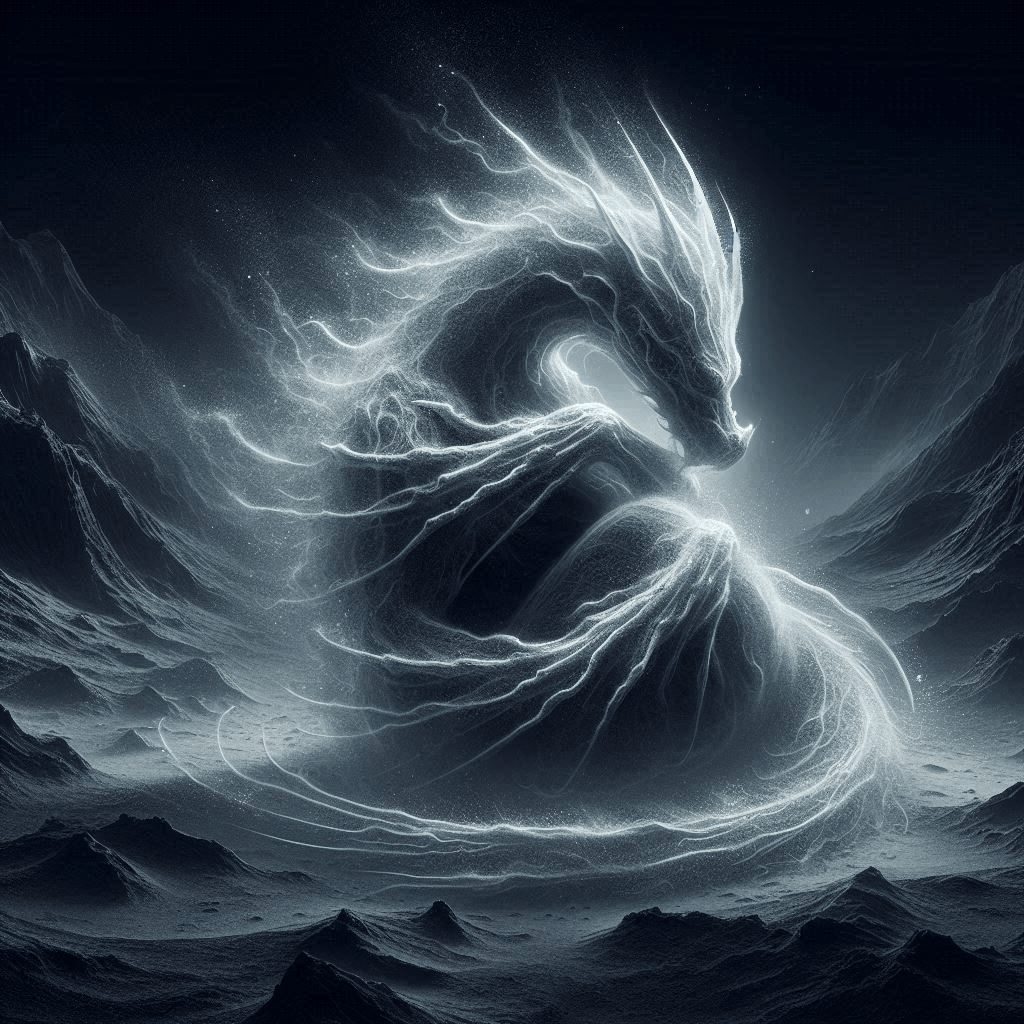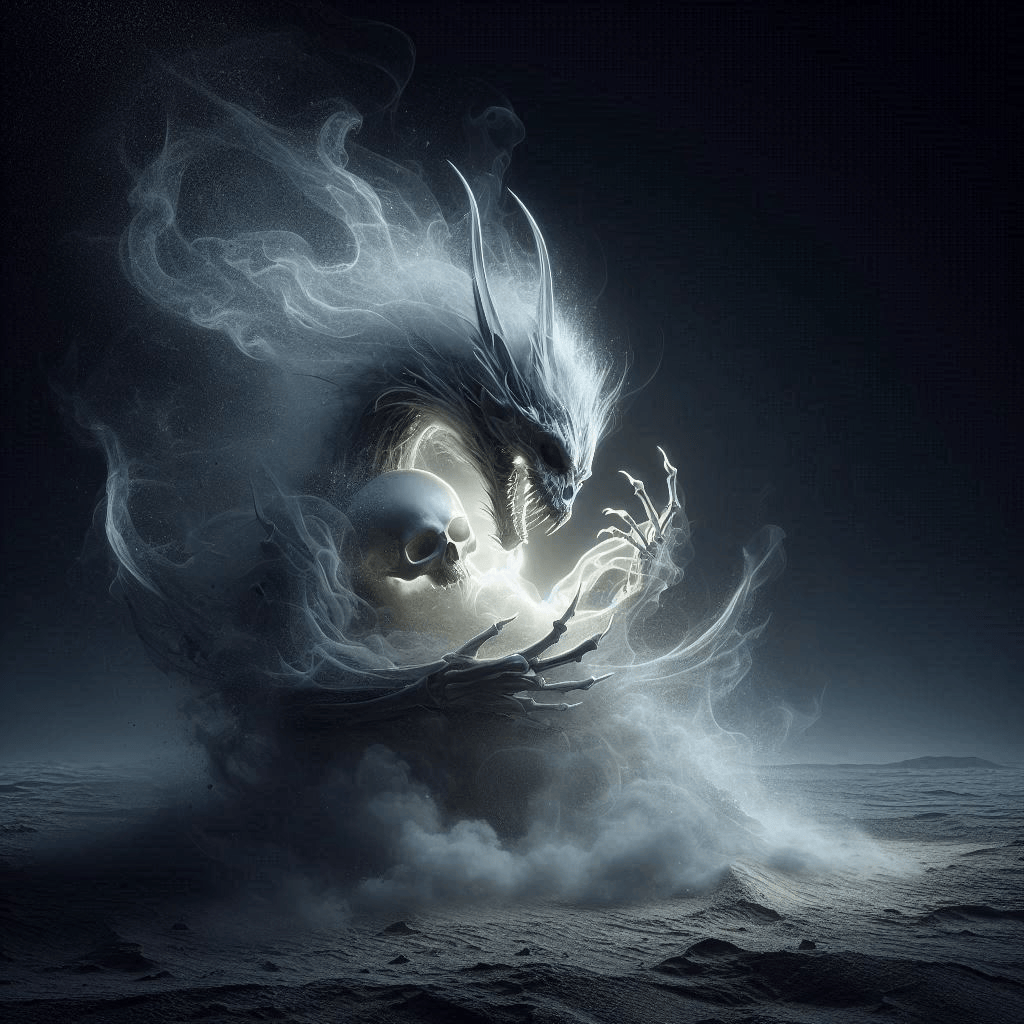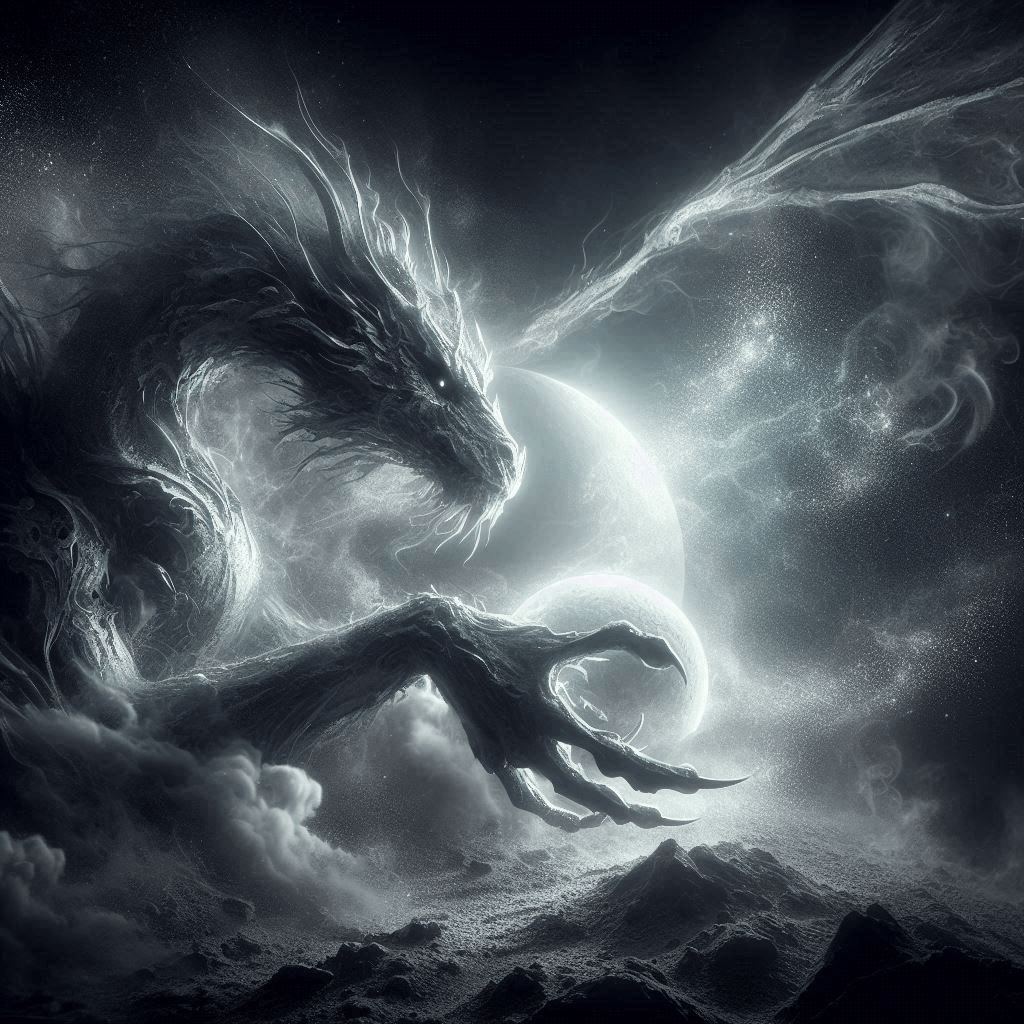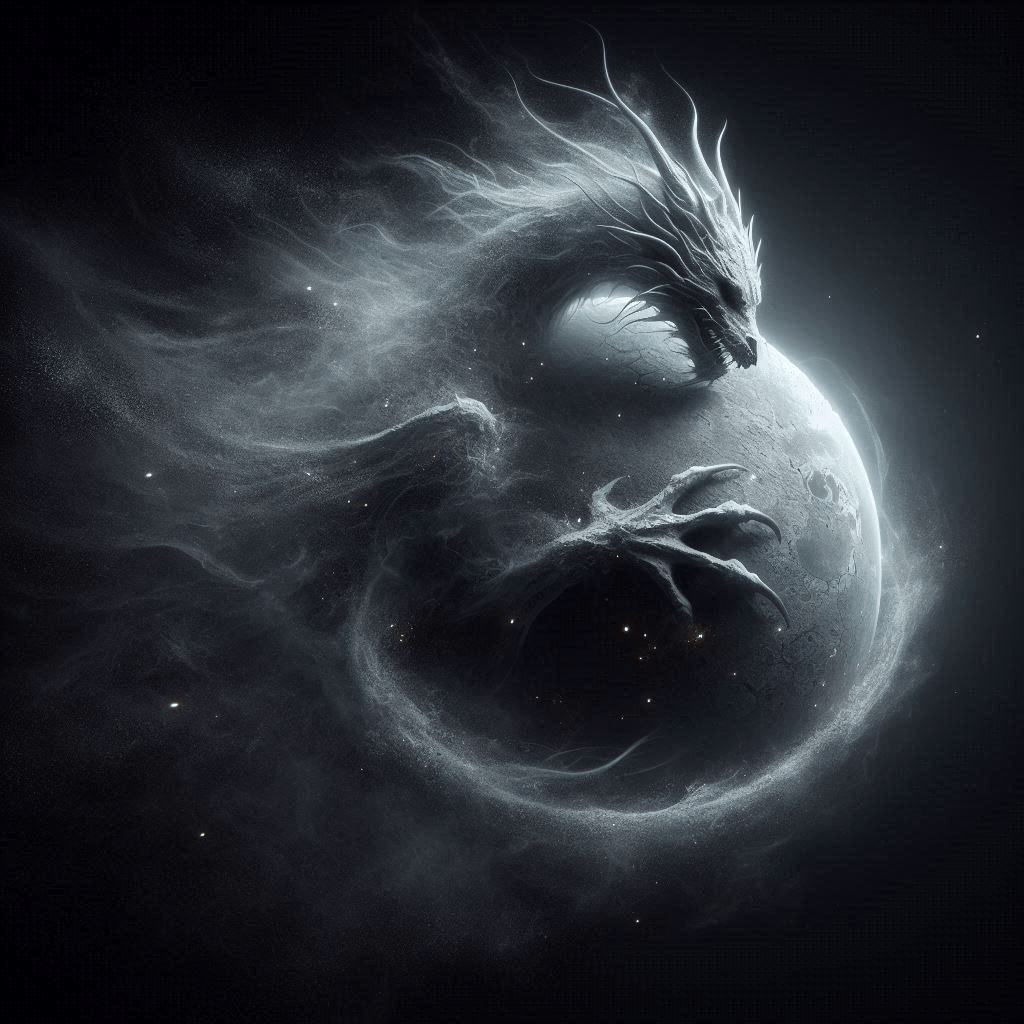Sixth stage of the Scorpion cycle

Hydra is a remnant.
It is not born – it remains.
When the sun finally appears (in the Lacerta stage), it blinds, burns, dries – and everything that did not manage to escape goes underground.
There, where moisture still holds memory, where bones are slowly ground by time, and where no one calls by name, because names are forgotten.
Hydra is the archetype of a living ghost: a creature made up of many old spines, tails, scales, paw prints. It has no form, but retains all the forms that were.
It has many heads, because each is a fragment of thought, body or desire left in the earth.
It does not die, because it has already died.
But it does not disappear – because something inside it remembers that not everything was in vain.
🦎 From Lacerta to Hydra: When the Spine Becomes Memory
Lacerta is the awakening of the spine, the first shock of the body, the first step into the outside world.
But it does not yet have a goal, and each new form is an attempt to grope its way through the labyrinth.
It seeks who to be, not what to remember.
Hydra is not a step forward, but a fall back.
It is all the memory of Lacerta that did not fit into the body.
That which remained behind the scenes of evolution.
It is not a vertebrate creature, but the memory of vertebrates, fragments of forms that did not pass the casting into reality, but still drag down.
If Lacerta is the archetype of bodily awakening, then Hydra is bodily exile.
It remains after bodily mistakes – and does not die.
🦠Archetype: Wandering Memory of the Spine
She does not live, but she does not die.
Hydra is not a body, but a memory of corporeality.
She is a trace of a being that once refused to admit that it could be destroyed.
Deprived of support, she stretches forward, as if the spine itself decided to continue the path, forgetting that there is nothing else to go.
Hydra does not know what death is, because she has never known life – only its form, inertia, gesture.
Each of her heads is an echo of past directions.
Each movement is a path that she once took, and now everything is repeated over and over, without will, without outcome, without end.
She seems to whisper: “As long as you remember, I am here.”
And even if you forget, she will remain – in the bend of an old root, in the bend of an underground river, in dreams, where the body is again in search of support.
Hydra is not the fear of death, it is the inability to die.
It lives in systems that were once alive – in codes, in bloodlines, in frozen instincts.
In mechanisms that continue to work without understanding why.
And yet, there is something noble in this ghostly immortality.
It preserves old knowledge: what it is like to be alive, to be a body, to be a goal.
It is the guardian of a path that can no longer be walked, but which still remembers how it was.
💀 Function
Hydra is the body’s collective memory.
It is not a “personality”, not a “psyche”, not a “soul”.
It is what remains when all three have left the flesh.
It is a recycler: it collects the remains, digests them for centuries, preparing the material for something new.
It lives in ashes, in clay, in fossils, in relics.
In myths, it is a beast that cannot be killed in the usual way: each head grows back, because its roots are not in the body, but in history.
🌊 Key traits
- Multiformity
- Fluidity of memory
- Immortality as the inability to disappear
- Archive of old bodies
- Underground wisdom
- Unconscious fear and attraction
- Refusal of light
- Eternal observation
🜄 Hydra — The One Who Has No Color
She does not come from the clan.
Not from the pack.
Not from her own.
Her body is discarded,
her skin is re-sewn,
her voice is sewn from the cries of others.
Hydra appears when no one is left.
When the clan burned out, the pack killed itself, and her own became a stranger.
She does not choose who to be with.
She does not remember where her “first skin” was.
Everyone who looks at her asks — “Are you one of ours?”
She answers — “Who are you?”
She does not look at the form. Not at the color.
But at how you tremble when your name is called.
At where you run when everything collapses.
At who you saved first.
Because she has no flag, but she has sensors.
She does not know how to be one of her own, but she can read lies.
She recognizes – by fear, by pain, by mutation.
And that is why she is dangerous.
Not because she is strong – she grew up in ruins.
Not because she is evil – she remembers too much.
But because she has no color.
And does not seek color for herself.
And does not believe that color means anything at all.

📦Archetype (from within)
Hydra is a body without actual consciousness, but with residual impulses. It is not a form of life that chooses – it reflects.
Its movement is not proactive – it is forced: like convulsions in a dead body, like an echo of forgotten emotions.
Hydra is not about sensations – it is about what was once a sensation.
This is the stage in which awareness of the body is like watching someone else’s dream, where the muscles sleep, and the tendons still remember the pain.
🦴 The spine as a bone archive
The hydra literally consists of archaeological layers of the spine.
The spine here is not an axis of movement, but a carrier of memory:
- An ichthyostega egg,
- A broken sauropod tail,
- A nervous bend in a pterosaur wing,
- A lemur’s neck twisted in fear.
It is not a body as a system, but a body as a museum, where everything frozen continues to rot, think, twitch.
🧬Sense of live
You don’t know if you’re alive.
You just are, because you can’t be anything else.
You don’t feel your heart – because it’s somewhere among the others.
You don’t know where your head is – because you have many of them, and they’re all looking in different directions.
😶 Consciousness and its absence
This is not stupidity. This is not sleep.
This is hyper-awareness that has lost its vector.
Consciousness here is like voiceless attention that cannot interfere.
You know, but you cannot say.
You see, but you cannot move.
You are like a surveillance camera buried in the dirt.
🦎 Body and form
The Hydra’s form is arbitrary:
- Sometimes it’s a worm with arms,
- Sometimes it’s a lump of cervical vertebrae with a jaw,
- Sometimes it’s a whole library of bodies, lying on top of each other like bone books.
You’re not in form – you contain forms.
You don’t know who you are: Lakerta? Salamander? Fish?
You remember them all, but you’re none of them.
🧠Psychophysics of Hydra
Hydra is felt as a residual movement living in the void.
You can be motionless, but inside your body it still crawls – slowly, groping, along old routes.
It does not breathe, but you feel how the body tries to inhale, as if remembering the breath that once was.
Sometimes this causes a slight shortness of breath, vibration in the bones, a feeling of blind searching – as if the spine itself turns the head back, but there is no head.
Hydra lives in the spinal cord, but not as a signal – as an echo of a signal.
You can feel it as a strange tingling along the spine, especially in those areas where there was once an injury or pinching – old energy nodes from which it “sprouts”.
Its movements are not initiated by will – they occur outside of context.
Hydra can “stand up” in the body at a moment when you are relaxed, frozen, distracted.
It is like a ghostly reflex that cannot be directly tracked.
As if something were moving inside you, but not by you.
Emotionally, it can cause melancholy, anxiety, especially when you remember “how it was”.
Not a specific event, but the fact itself: that you once had a body that moved forward, no matter what.
Hydra is a survival impulse deprived of a body.
Sometimes it makes you strong – due to the mechanism. Sometimes – helpless, because the mechanism does not know where to go now.
At the peak of activity, it feels like a process in which the whole body seems to “assemble”, but cannot assemble completely.
Like a tremor of the spirit, remembering muscle memory that is no longer there.
And all this – in complete silence. It does not make noise. It does not moan. It whispers from the depths: “Here I come”.

🌑Elements and astrology: Hydra
There will be no active aspects, fire or bright configurations here. Everything disintegrates and settles.
This is no longer a life chart – but a residual field superimposed on ashes.
Element: Water – but not flowing. This is stagnant water, deep, dead, sometimes even salty, like an inland sea with no outlet. Water that was movement, but became a memory of it. These are not feelings, but a sediment of feelings, not life, but the inertia of life. Sometimes ice. Sometimes swamp viscosity. Sometimes – bottomless darkness, where there are not even fish.
Quality: Fixed – despite its aquatic nature, Hydra is absolutely fixed. It cannot be persuaded, distracted or dragged into another channel. It is what remains. And remains. It accumulates, like pressure, sediment, scar.
Sign: closest – Scorpio, but not the one that stings, but the one that has already drowned and remains at the bottom. Metaphysical, buried Scorpio. Archetype of memory, darkness and survival after death.
In an alternative interpretation, this is the Island of Homeless Cancer at the edge of the Zodiac. Where no one lives, but empty shells, forgotten bodies and reflexes still move. Perhaps this is an additional zodiacal layer, a ghostly belt between Scorpio and Sagittarius, not included in traditional maps.
Planet/power: Pluto, but also a dead Pluto, Pluto as residual gravity. Sometimes it is activated from retrograde movements, from resonances with karmas of others, from unfilled voids in the ancestral memory.
Alternatively, secondary Saturn, not in the sense of karma, but as a shadow of the structure, an invisible rule that continues to operate even when all contexts have disappeared.
House: the 12th house, but not as a secret, but as a place where everything has already happened. This is an anatomical basement where the old will sleeps. Not hidden – but remote, like a backup copy of the body and spirit.
Sky Mark: If tied to the sky, perhaps the constellation Hydra, huge, scattered, serpentine, indomitable. But the true entry point is somewhere between Alphard and the shadow of Pollux. On the edge of water and air, living and dead, human and ghost.
🌀Transition: Hydra realizes itself not as a body, but as a ghost
Hydra is no longer a body, but not a spirit either.
She is an anatomical ghost, consisting of:
- knowledge of forms,
- the pain of bodies,
- the feeling that everything was in vain.
And only having realized this – that she has already died,
but still clings to form,
Hydra gets a chance to be reborn in something else.
Not in a body – but in a structure.

